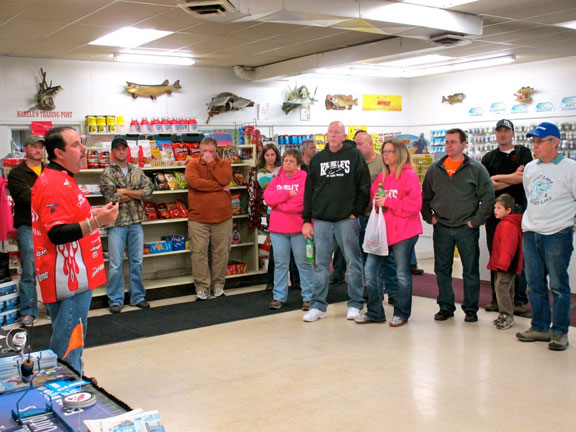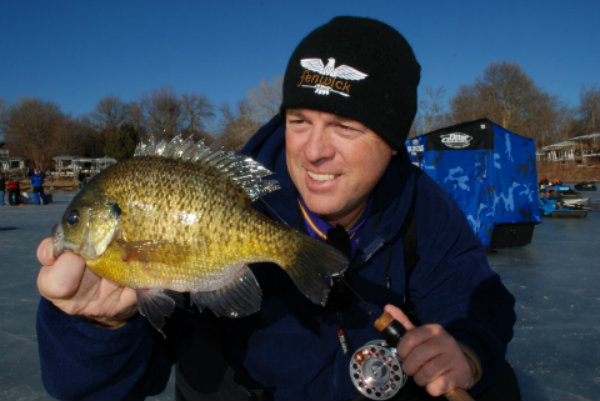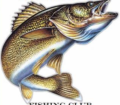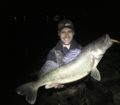By Steve Weisman
Outdoor Writer

(photo by Steve Weisman) Scott Reed shares his “One-Two Punch” with those in attendance at the recent “Shop With The Pros” even held at Kabele’s Trading Post last Saturday
Here it was Saturday, November 15, and no ice in sight. Yet over 250 ice fishing enthusiasts enjoyed a day of talking ice fishing at the “Shop With The Pros” event held at Kabele’s Trading Post.
People came and left throughout the day as they looked at the new ice fishing products, talked about last year and what this year might bring and listened to ice fishing pro-staffers share ice fishing tips and participate in Q & A opportunities.
Thane and Tanya Johnson, owners, were ecstatic with the results of the day. Tanya reflected, “It was a great day of events at our first ever ‘Shop With The Pros’ event. We had people come from over five hours away, and many stayed from beginning to end to listen to the seminars by our pro-staffers. We look forward to having this again next year!”
Tanya concluded, “Thanks to our sponsors and pro-staffers. It was an amazing feeling to look around the room and see everyone holding something we had given them as a thank you for attending.”
Over the next couple of weeks I’ll share some of the notes I took during these pro-staff sessions. First up, Scott Reed, District Sales Manager for Pure Fishing and an accomplished ice angler, who shared what he calls the “One-Two Punch.”
The One-Two Punch
The “One-Two Punch” begins with what all of the pro-staffers noted was important: mobility! Reed believes that drilling new holes means the opportunity to find new fish and often times that ‘first drop’ down a new hole is the best. You never know, the fish might be only a few yards away, but if no new holes are explored, you will never know. By using multiple lines one can cover the “lateral water column” as well as the “vertical water column” and garner more information more quickly.
Reed’s one-two punch includes what he calls “Active Presentations and Passive Presentations.” No matter the species he targets, for Reed, ‘active presentation’ means working a lure through the vertical water column. As he works the lure, he’s constantly looking for feedback from the active fish by watching his graph and/or underwater camera.
Are they responding to a certain color? How about the size of the lure? Do they want vertical or horizontal lures? What do they want for movement? What depth do they prefer? Reed notes that ‘cadence’ or as Dave Genz calls it “the swim” is VERY important and a successful angler will ‘mix it up’ and try various jigging motions. Are they hugging the bottom or rising to meet the lure? Knowing how to read your graph is important, and a camera or ‘sight fishing’ can elevate this learning curve.
Passive presentation
At the same time, Reed’s second rod is in passive mode. It might be a slip bobber rig, a spring bobber, a dead stick rod or even a tip-up. “I will often fish this lure or bait higher in the vertical water column than the rod I am actively using. I might have the second rod with me in the shack only 2-3 feet away or maybe a few feet away out on the ice in a Berkley bucket rod holder. If I am fishing bluegills on West Okoboji and the northern pike are coming through and spooking the bluegills from my active presentation, I will set up a tip-up baited with a chub or small bluegill as many as 40 yards away. I might not get many hits on it, but the notion is that it will help keep the larger predator fish away from the smaller presentation targeted towards panfish.”
As Reed continued his presentation, he shared the importance of having several active and several passive rigs ready when he takes to the ice. “To me, it’s about efficiency and being able to have an answer to the many variables that appear during a fishing outing.” Reed made the analogy, “It’s kind of like golfing. You can use one club, say a five-iron and drive, chip and putt with that one club. However, there is more efficiency and enjoyability when you have a variety of clubs.”
The same holds true with ice fishing. The more rods that offer a variety of presentations, the more efficient you can be. “There is a best tool for every situation,” Reed went on to say.
Line choices
Another important aspect to ice fishing (any fishing for that matter) is line choice. If anybody knows fishing lines, it has to be Scott Reed! Monofilament is probably the most used fishing line category. The Trilene knot or Improved Clinch knot works best here. However, nylon monofilament does absorb water and become weaker and can also weaken from exposure to UV rays.
Fluorocarbon line does not absorb water, is invisible under water and is more abrasive and UV resistant than nylon based monofilament. A negative to Flourocarbon is that it does have more memory or stiffness than a nylon fluorocarbon of the same size. To tie a good knot with Flourcarbon, anglers are highly encouraged to wet the line and the Polomar knot works best in this case.
A ‘Super Line’ such as Fireline or Spiderwire offers little to no stretch and both are very sensitive when responding to light bites or lures at depth. Reed notes that the new NanoFil from Berkley is the smoothest of all ‘Superlines’ and is well suited to ice fishing. Since NanoFil is extremely slick and slippery, Reed suggests tying a double Palomar knot or a NanoFil Knot.
Next week, we’ll take a look at more ice fishing tips from the pro-staffers at the “Shop With The Pros” event.
Editor’s Note: Steve Weisman, a retired teacher, is a member of OWAA and AGLOW and has been a free lance outdoor writer for the past 19 years. He writes for several publications throughout the Midwest. A true outdoorsman, Steve enjoys sharing news about the outdoors through his own experiences and the information gained from DNR wildlife and fisheries biologists and outdoor experts. Contact Steve at stweis@mchsi.com.














great article steve!!